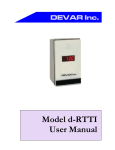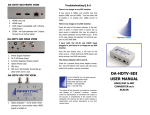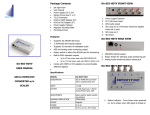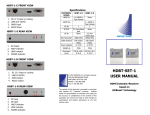Download Model PB-LPI Loop Powered Indicator User`s Manual
Transcript
DEVAR Inc. Model PB-LPI Loop Powered Indicator User’s Manual Table of Contents 1. General Description ........................................... 1 2. Installation .......................................................... 2 3. Field Wiring ........................................................ 4 4. Configuration ...................................................... 5 5. Offset Function ................................................... 7 6. Specifications ..................................................... 8 List of Illustrations Fig. 1 General Dimensions .............................. 2 Fig. 2 Rear Panel ............................................ 3 Fig. 3 Panel Cutout ......................................... 3 Fig. 4 Typical Wiring ........................................ 4 Section 1 General Description The PB-LPI is a two-wire digital indicator that monitors a 4 to 20 mA process signal and provides local indication on a liquid crystal display. The meter features four active digits with half inch high, easy to read characters that can be displayed with or without backlight. The meter requires no external power supply as it derives its power directly from the 4 to 20 mA input signal, dropping only one volt across its input terminals when the backlight is not used and approximately five volts when the backlight is turned on. The PB-LPI provides a digital readout directly proportional to the milliamp input. The indicator is configured at the factory to display zero to one hundred percent for a 4 to 20 mA input signal, however it can be easily reconfigured in the field to read directly in engineering units (e.g. oF, GPM, feet of water ...). Configuration of the PB-LPI is accomplished using three buttons located at the rear of the display. The display can be forward or reverse acting and can be configured to display any combination of numbers between –1999 and +9999. The Housing is constructed of rugged polycarbonate with an acrylic window. Once properly installed in the panel, the exposed front side of the meter is NEMA 4X, suitable for indoor or out door use. 1 Section 2 Installation The meter is installed through a 3 inch diameter hole in the in the Panel and locked in place using two 6-32 threaded studs and two 5/8 inch long hex nuts, which are located diagonally at the rear of the enclosure. Two 0.144 diameter holes must be drilled in the panel for the threaded studs. 0.497 3.250 0.532 0.342 3.250 DEVAR Inc. 0.625 Fig. 1: General dimensions 2 DEVAR Inc. BRIDGEPORT CT 06605 www.devarinc.com LIGHT ON MOVE + IN A LIGHT OFF + IN B SPARE INPUT SCROLL - IN 4 TO 20 mA FUNCTION MODEL PB-LPI DIGITAL LOOP POWERED INDICATOR SN Fig. 2: Rear panel 0.144 3.000 3.500 Fig. 3: Panel cutout 3 Section 3 Field Wiring A four position terminal block is provided at the rear of the meter for field wiring. To operate the meter with the backlight turned on, wire between the +IN A and the –IN terminals. To operate the meter with the backlight turned off, wire between the +IN B and the –IN terminals. A SPARE terminal is also provided as a tie point. + - POWER SUPPLY + IN A + IN B + SPARE - IN + - 2-WIRE TRANSMITTER Fig. 4: Typical wiring - showing a 2-wire transmitter powered by an external power supply with the backlight turned on 4 Section 4 Configuration The PB-LPI is configured at the factory to display 0 to100% for a 4 to 20 milliamp input signal. Reconfiguration is easily accomplished using the “MOVE”, “SCROLL” and “FUNCTION” buttons located at the rear of the meter. To configure the PB-LPI the meter is put into the Configuration Mode where the user will be prompted to set the following operating parameters: 1. (dP) Position of decimal point 2. (HI) Number displayed at 20 mA 3. (LO) Number displayed at 4 mA 4. (OFFS) Offset (or zero shift) applied to reading 4.1 Enter Configuration Mode There are two ways to enter the Configuration Mode. The first is to apply a signal to the indicator. As the indicator powers up, the configuration prompt COnF appears. The second method is to simultaneously press all three buttons on an operating meter for a period of five seconds. This action also causes the configuration prompt to appear. Once the configuration prompt appears, the operator has 30 seconds to press the FUNCTION button and begin configuration. 4.2 Define position of the Decimal Point The first prompt to appear is dP. Press the FUNCTION button to display “1 2 3 . 4”. Use the MOVE button to change the position of the decimal point and then press the FUNCTION button to 5 enter your selection. The meter will momentarily display dOnE indicating that the selection has been entered. 4.3 Define number displayed at 20 mA The second prompt to appear is HI. Press the FUNCTION button to display a four-digit number. The active digit will be flashing. Use the SCROLL button to change the value of the active digit and then use the MOVE button to move to the next digit. Once all the digits are reading correctly, press the FUNCTION button to enter your selection. The meter will momentarily display dOnE indicating that the selection has been entered. 4.4 Define number displayed at 4 mA The third prompt to appear is LO. Press the FUNCTION button to display a four-digit number. The active digit will be flashing. Use the SCROLL button to change the value of the active digit and then use the MOVE button to move to the next digit. Once all the digits are reading correctly, press the FUNCTION button to enter your selection. The meter will momentarily display dOnE indicating that the selection has been entered. 4.5 Enter an offset value The last prompt to appear is OFFS. Press the FUNCTION button to display a four-digit number. The active digit will be flashing. Use the SCROLL button to change the value of the active digit and then use the MOVE button to move to the next digit. Once all the digits are reading correctly, press the FUNCTION button to enter your selection. The meter will momentarily display dOnE indicating that the selection has been entered. 6 Section 5 Offset Function The Offset Function allows the user to apply an offset value (or zero shift) to his readings. An example of this is measuring water level in a well using a submersible pressure transducer that is suspended two feet above the bottom of the well. If the transducer outputs 4 mA at zero feet of water and 20 mA at 23 feet of water, the display could be configured as follows: HI = 23.00 LO = 00.00 OFFS = 02.00 If the transducer was lowered to one foot above the bottom of the well, the offset would be changed to one foot and if the transducer was lowered to the bottom of the well, the offset would be changed to zero feet. 7 Section 6 Specifications 1. Input a. Range ................................... 4 to 20 mA b. Voltage drop (light on) ........... 5.2 VDC c. Voltage drop (light off) ........... 1 VDC d. Maximum forward current ..... 60 mA e. Maximum reverse current ..... 100 mA 2. Display a. Type ...................................... 4 digit, LCD, 1/2” high digits b. Backlight ............................... LED, hyper-orange selected by input wiring 3. Configuration a. Display at 20 mA ................... -1999 to 9999 counts b. Display at 4 mA ..................... -1999 to 9999 counts c. Zero offset range ................... -1999 to 9999 counts d. Decimal point ........................ User selectable e. Selection method .................. Push buttons 4. Performance a. Resolution ............................. 16 bits b. Calibration accuracy ............. ± 0.05% of span c. Temperature effect ................ ± 0.01% of span / oC, typ. d. Temperature range ............... -30 to +85 oC 5. Enclosure a. Material ................................. Polycarbonate body Acrylic window b. Rating .................................... NEMA 4X (front face) 8 NOTES




















